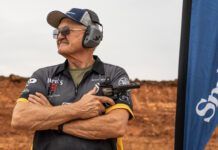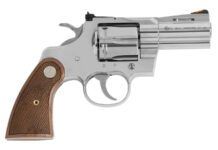The U.S. Ordnance Board has always invited side-arm manufactures to pit their designs against the competition to determine which firearms are best suited for combat. The Colt Single Action Army (SAA) seemed like a shoe-in after the Civil War because the Army liked the Colt Model 1860 percussion revolver. The Remington 1858 cap-and-ball revolver was also popular with the Army, but the days of loose powder and ball were ending. By 1870, technology had evolved, and Smith & Wesson had an edge, and Government orders. S&W sold the Army on the Model 3 revolver in 1870, which was the first self-contained metallic-cartridge-firing sidearm in U.S. service. Cartridges today are taken for granted, yet back then, cartridges were cutting-edge weaponry. The Army tweaked the Model 3 design and landed on a variant of the Model 3 called the Schofield revolver chambered in 45 S&W, also called 45 Schofield.
We decided to take a look at four modern replicas of single-action revolvers that were introduced between 1870 and 1875 and do our own abbreviated version of sidearm trials circa 1873. We looked for accuracy, point of aim, trigger weight, ease of use, and smooth actions.
Our entrants included a third-generation Colt SAA, which is descended from the original Colt SAAs used by the Army; an Uberti Outlaw Army, which is a replica of the Remington Model 1875; an Uberti 1873 No. 3 Top Break Model, which is a near clone of a Smith & Wesson No. 3 Schofield revolver and another revolver adopted by the Army; and finally a 21st-century newcomer from Taylor’s & Co. called the Drifter, which is similar to a traditional SAA revolver but with upgrades.
All of these revolvers are full size with either a 7- or 7.5-inch barrel. They all are chambered for 45 Colt, have fixed sights, six-round capacity, and are single action only. You need to cock the hammer then squeeze the trigger to make these old-timers go bang. The firing pin is built into the hammer, so the safest way to carry these revolvers is with the hammer resting on an empty chamber. The Schofield and Outlaw have a hammer-safety block that is activated when you cock the hammer back until you hear the first click. The Taylor’s uses Uberti’s retractable firing-pin safety system used in Uberti’s 1873 Cattleman II revolvers. The Colt uses late 19th-century technology that relies on the user’s common sense rather than a manual or built-in safety.
The Taylor’s, Colt, and Uberti Outlaw are similar in that they employ a right-side loading gate and ejector rod to load and unload the revolver one chamber at a time. The Uberti 1873 No. 3 is a top-break design that allows the user to flip a latch and rotate the barrel and cylinder away from the frame to eject all the empty shells at the same time. You can see right away that the Uberti/S&W Schofield has an edge with the ability to load and unload more rapidly than the other revolvers. With the other revolvers, the shooter loads and unloads one chamber at a time. Tedious at best, and we imagine nerve-racking when in a gunfight. While the Schofield has the advantage in loading and unloading, the original Schofield fired the 45 Schofield/45 S&W cartridge, which is shorter than the 45 Colt. The cartridge used a similar bullet weight as the 45 Colt, and on average, the velocity was 100 fps less. The 45 Schofield is also compatible with 45 Colt guns, so back in the day, the Army used the 45 Schofield cartridge in Colt SAA revolvers. Unfortunately, the 45 Colt could not be used in guns chambered for 45 Schofield. This was the downfall for the S&W Schofield revolver’s wider acceptance. The Army preferred the power of the 45 Colt cartridge, and the Army had plenty of 45 Colt ammo on hand, so the Schofield was dropped from the ranks. Luckily, Uberti’s modern take on the Schofield revolver chambers it in 45 Colt, so the Uberti is not an exact replica, but it is close enough for Government work.
We decided to test both 45 Colt and 45 Schofield ammunition. For the 45 Schofield round, we used Choice Ammunition 200-grain RNFP (Round Nose Flat Point) lead Black Hi-Tek. The non-toxic Black Hi-Tek coating encapsulates the lead bullet, replacing standard dry lubricant. Hi-Tek coating has been used for years in other countries and shoots cleaner than bare lead. We can attest that the Choice Ammunition loads do shoot cleanly. This ammo is made in Montana. For 45 Colt rounds, we used a 250-grain RNFP Lead Hi-Tek Black from Choice Ammunition, a 255-grain RNFP from Hornady’s Cowboy line, and 250-grain LFN loads from Sellier & Bellot. Those cartridges rounded out the low-velocity cowboy-action-shooting-style loads. The modern 45 Colt load was a SIG V-Crown cartridge loaded with a 230-grain JHP bullet.
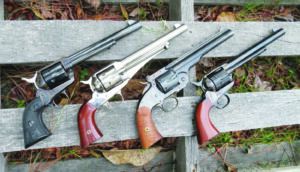
For accuracy testing we used our range bag as a rest and thumbed away at targets set at 15 yards. Our first impression was that some of the front-sight blades were thin and hard to see. We understand the adage “aim small, miss small,” but we needed to concentrate to be surgical with Outlaw and Schofield. All revolvers shot to point of aim, which can be a hurdle for some fixed-sight revolvers.
The triggers were the next characteristic that left an impression. The Colt had the worst trigger of the bunch, yet was the most expensive. The Taylor’s trigger and action were silky, and the Outlaw and Schofield started to smooth out after repeated firing.
The third thing were the grips. The Colt and Taylor’s were typical SAAs with flat sides that flared out toward the bottom of the grip. We thought the Colt grips were toothy enough so the gun didn’t slip in our hand during recoil. The Taylor’s grip was smooth. The Outlaw had a fatter and rounded grip that filled our hands without it feeling too chunky. The Schofield grip was small, like a grip on a compact revolver.
For fast shooting, we used a Thompson Targets B27STOP Upper Torso Life Size Silhouette target ($7/5; ThompsonTarget.com), which features a T-shaped head and chest zone highlighted in bright red. We fired single hand and two handed, using our support hand to cock the revolvers. Two-handed hold dramatically increased speed. We pushed ourselves on speed and found we could get lead downrange fast and accurately when we aimed for center of mass. The head shots took a little more time and finesse.
All in, we had fun with these modern renditions of late 19th-century revolvers, and we appreciated the workmanship as well as mixing old technology with new. These may have been vintage pieces, but we never felt undergunned had we needed to use them for home defense. Here’s what else we discovered about these new-antique revolvers.
Gun Tests Grade: B
$729
The Remington Model 1875 was late to the party and to the Government contract. The military already awarded Colt the lion’s share of the contract, but they did buy a few Remingtons for Native American reservation police. The Model 1875 was Remington’s first metallic cartridge revolver, and it went over like a lead balloon. It was much heavier than the Colt and S&W, and was not as popular back in the day.
| Action Type | Revolver, single action, hammer fired |
| Overall Length | 13.1 in. |
| Barrel Length | 7.5 in. |
| Barrel Twist Rate | 1:16 in. RH |
| Sight Radius | 8.3 in. |
| Overall Height | 5.5 in. |
| Maximum Width | 1.6 in. |
| Weight Unloaded | 47.5 oz. |
| Weight Loaded | 52.7 oz. |
| Cylinder Gap | 0.006 in. |
| Capacity | 6 |
| Frame Finish | Nickel |
| Barrel/Cylinder Finish | Nickel |
| Frame Front Strap Height | 2.1 in. |
| Frame Back Strap Height | 3.4 in. |
| Grip | Smooth walnut, two piece |
| Grip Thickness (Maximum) | 1.5 in. |
| Grip Circumference (Maximum) | 6.0 in. |
| Front Sight | Fixed blade |
| Rear Sight | U-notch |
| Hammer Cocking Effort | 3.8 lbs. |
| Trigger Pull Weight | 2.9 lbs. |
| Trigger Span | 3.1 in. |
| Safety | None |
| Warranty | 1 year |
| Telephone | (540) 722-2017 |
| Website | TaylorsFirearms.com |
| Made In | Italy (Uberti) |
Uberti no doubt chose the name, Army Outlaw, for their Remington Model 1875 replica because the original Remington was intended for military use and the fact that Frank James, Jesses James’s older brother, carried a Model 1875.
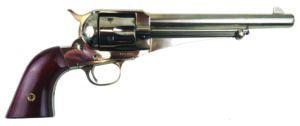
Our sample is a full-nickel-plated variant with charcoal-blue screws and cylinder pin, and a smooth walnut grip. It is a sharp looking six-shooter with a nice finish and well-fitted grips. On current models Uberti added a hammer-block safety in the hammer. There is a small slot at the rear of the hammer that shows the hammer-safety block. To activate the hammer-safety block, pull the hammer rearward until you hear the first click. With the hammer in this position, a steel insert between the hammer and the frame is designed to prevent the gun from firing accidentally. Can you carry six cartridges safely? Uberti and we suggest you keep to the Load-One, Skip-One, Load-Four rule.
In hand, the Army Outlaw is a hefty 52.7 ounces fully loaded. Carrying that weight on your hip may be tiring, but in use, the weight of the Army Outlaw helps with recoil management. The extra weight is contributed by the blade, which is a piece of metal under the barrel that attaches to the frame. This makes the Army Outlaw sturdy as a brick outhouse.
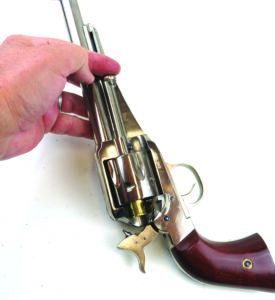
The grip shape and angle are unique to the design as well. The grip is extended from the frame more than the Colt and Taylor’s, so reach for the trigger span is 3.1 inches. On the Colt and Taylor’s, the trigger span is 2.8 and 2.7 inches, respectively. We found this was an issue when we fired for speed. The rear of the trigger guard jammed up against the knuckle of our middle finger under recoil. It wasn’t painful, but it is something to consider depending on the size of your hand. Large-hand testers had no issues. The grip felt round in hand, like we were grasping an ear of corn. It was also fuller compared to the Colt and Taylor’s. The trigger was also nearly as wide as the trigger guard and twice the width of the Colt and Taylor’s triggers, but shorter. Because the grip was extended, we found our trigger finger was higher on the trigger and touched the top edge of the inside of the trigger guard. It wasn’t as clean a squeeze on the trigger as we would like.
The hammer-cocking effort took a fairly easy 3.8 pounds and trigger broke at a fairly crisp 2.9 pounds. While the trigger pull weight was okay, the front sight was thin and tapered at the top to an edge. The rear sight was U-shaped. The nickel finish made the sights shiny with sun glare. We used some powder residue to dull the front-sight blade’s glare.
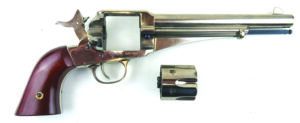
Our best group measured 1.55 inches with Hornady Cowboy loaded with a 255-grain RNFP bullet; average groups measured 1.91 inches. The worst-grouping ammo was the modern SIG V-Crown with a 230-grain JHP; the smallest group measured 2.41 inches and averaged 2.70 inches. The Army Outlaw did like the 45 Schofield ammo; the smallest group measured 1.60 inches and average was 1.77 inches. Looking at the average of combined ammo across all guns tested, the Army Outlaw was least accurate. That might sound severe, but across all ammo, average group size measured 2.02 inches for the Army Outlaw. That’s still good for Government work.
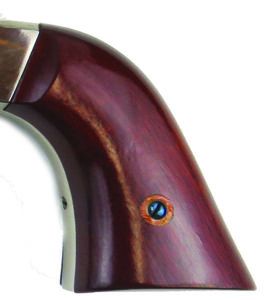
Shooting for speed, we felt the weight of the Army Outlaw helped us manage recoil better. We did get jammed a few times in the knuckle, and we were slower than with the Colt and Taylor’s.
Most empty cases fell free from the chambers, and when we did use the ejector rod, we found it was located on the right side of the barrel, the opposite side compared to the Taylor’s and Colt.
The Army Outlaw field-strips like the Taylor’s and the Colt except the cylinder pin is captured in the blade so it can’t get lost or dropped in the grass or snow. We thought this was a clever design feature.
Our Team Said: We understand why the military gave a cool reception to the Remington Model 1875. We also think we discovered why it was not as popular back in the day: its heavy weight and unique grip angle. Uberti has done an excellent job of recreating a period-piece revolver with modern safety features. This unique revolver offers great fun shooting a period piece.
45 Colt Range Data
To collect accuracy data, we fired five-shot groups from a bench using a rest. Distance: 15 yards with open sights. We recorded velocities using a ProChrono DLX digital chronograph set 10 feet from the muzzle.| SIG V-Crown 230-grain JHP | Colt Single Action Army | Taylor’s & Co. Drifter | Uberti 1873 Top Break | Uberti Outlaw |
| Average Velocity | 912 fps | 784 fps | 846 fps | 750 fps |
| Muzzle Energy | 425 ft.-lbs. | 314 ft.-lbs. | 366 ft.-lbs. | 287 ft.-lbs. |
| Smallest Group | 1.70 in. | 2.41 in. | 2.13 in. | 1.57 in. |
| Average Group | 2.15 in. | 2.70 in. | 2.23 in. | 1.78 in. |
| Hornady Cowboy 255-grain RNFP | Colt Single Action Army | Taylor’s & Co. Drifter | Uberti 1873 Top Break | Uberti Outlaw |
| Average Velocity | 782 fps | 679 fps | 738 fps | 648 fps |
| Muzzle Energy | 346 ft.-lbs. | 261 ft.-lbs. | 308 ft.-lbs. | 238 ft.-lbs. |
| Smallest Group | 3.22 in. | 1.55 in. | 2.10 in. | 1.22 in. |
| Average Group | 3.29 in. | 1.91 in. | 2.36 in. | 1.26 in. |
| Sellier & Bellot 250-grain RNFP | Colt Single Action Army | Taylor’s & Co. Drifter | Uberti 1873 Top Break | Uberti Outlaw |
| Average Velocity | 890 fps | 843 fps | 809 fps | 808 fps |
| Muzzle Energy | 440 ft.-lbs. | 395 ft.-lbs. | 363 ft.-lbs. | 362 ft.-lbs. |
| Smallest Group | 0.95 in. | 2.53 in. | 1.82 in. | 2.88 in. |
| Average Group | 1.31 in. | 2.68 in. | 2.03 in. | 3.24 in. |
| Choice Ammunition 250-grain RNFP | Colt Single Action Army | Taylor’s & Co. Drifter | Uberti 1873 Top Break | Uberti Outlaw |
| Average Velocity | 888 fps | 823 fps | 846 fps | 788 fps |
| Muzzle Energy | 438 ft.-lbs. | 376 ft.-lbs. | 397 ft.-lbs. | 345 ft.-lbs. |
| Smallest Group | 1.71 in. | 2.02 in. | 1.10 in. | 1.87 in. |
| Average Group | 1.92 in. | 2.17 in. | 1.32 in. | 1.92 in. |
45 Schofield Range Data
To collect accuracy data, we fired five-shot groups from a bench using a rest. Distance: 15 yards with open sights. We recorded velocities using a ProChrono DLX digital chronograph set 10 feet from the muzzle.| Choice Ammunition 200-grain RNFP | Colt Single Action Army | Taylor’s & Co. Drifter | Uberti 1873 Top Break | Uberti Outlaw |
|---|---|---|---|---|
| Average Velocity | 883 fps | 839 fps | 839 fps | 822 fps |
| Muzzle Energy | 346 ft.-lbs. | 313 ft.-lbs. | 313 ft.-lbs. | 300 ft.-lbs. |
| Smallest Group | 1.60 in. | 1.64 in. | 1.80 in. | 2.75 in. |
| Average Group | 1.76 in. | 1.77 in. | 1.82 in. | 2.77 in. |




























